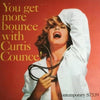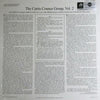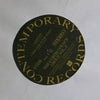





Curtis Counce - You Get More Bounce With Curtis Counce! Vol. 2 (2LP, 45RPM, unsealed, Number 0293)
Rarity - Unsealed (Mint conditions)
Bass – Curtis Counce
Piano – Carl Perkins [Click here to see more vinyl featuring Carl Perkins]
Drums – Frank Butler
Tenor Saxophone – Harold Land
Trumpet – Jack Sheldon
Written by Curtis Counce (A1, C2), Irving Berlin (A2), George Weiss (B1), Jerry Bock (B1), Larry Holofcener (B1), Fred E. Ahlert (B2), Roy Turk (B2), Aleksandr Porfirevich Borodin (C1), George Forrest (C1), Robert Wright (C1), Charlie Parker (D1)
2 LP, standard sleeve
Limited number edition - Number 0293)
Original analog Master tape : YES
Heavy Press : 180g
Record color : black
Speed : 45RPM
Size : 12”
Stereo
Studio
Record Press : unspecified
Label : Analogue Productions
Original Label : Contemporary Records
Recorded on October 8 & 15, 1956, April 27, May 13 and September 3, 1957 at Contemporary Studios in Los Angeles, California
Engineered by Roy DuNann
Produced by Lester Koenig
Cover design by Robert Guidi
Liner Notes by Nat Hentoff
Photography by Hal Adams
Originally released in 1957
Reissued in 2006
Tracks:
Side A:
- Complete
- How Deep Is the Ocean
Side B:
- Too Close for Comfort
- Mean to Me
Side C:
- Stranger in Paradise
- Counceltation
Side D:
- Big Foot
Reviews :
“(…) the program features the underrated but talented Curtis Counce Quintet of 1956-1957, a group consisting of the bassist/leader, trumpeter Jack Sheldon, tenor saxophonist Harold Land, pianist Carl Perkins, and drummer Frank Butler. Counce contributed two originals but otherwise the band sticks to jazz standards, with some of the best moments being on "Too Close for Comfort," "Mean to Me," and Charlie Parker's "Big Foot." AllMusic Review by Scott Yanow
“When bassist Curtis Counce died of a heart attack at the age of 37 in 1963, the jazz world was deprived of a major talent. Not that one would have known much, for his death, while noted, was not extensively covered. Counce, a Midwesterner, had come to California and to Los Angeles to learn his craft, where he played with such incubator orchestras at the Club Alabam as Johnny Otis (trumpeter Art Farmer started there too). He gigged in the best circles, with Wardell Gray, Hampton Hawes, Benny Carter, Shorty Rogers, and Buddy DeFranco. Counce toured Europe with Stan Kenton in 1956 and opened with his own group at the Haig in Los Angeles, a club whose name is synonymous with bebop in jazz history. While he had previously recorded with Lester Young and Shelly Manne, his first album came with Contemporary Records in 1957. Later the same year it was followed by what is now regarded as a classic, You Get More Bounce With Curtis Counce. If anything, people remember the cover. Too bad. The music mattered more.
There is a story (it cannot be verified) that a member of Counce's family took offense at the original cover, a typical sort of 1950 cheeesecake with a strawberry blonde checking out her heart sounds. Of course, her blouse was strategically unbuttoned, as if taking a physical for a certain men's magazine. So, the story goes, the recording was subsequently reissued with a less provocative cover and title. Maybe, maybe not. What is certain is that this recording is very good. If not uniformly excellent, it is, on average, a real winner.
Part of it, of course, is Counce, who was an exceptional bassist, not some first and third beat plunker who stuck to roots. He had an extraordinarily refined sound, so resonant as to suggest he was sometimes playing against his own beat. He was an excellent soloist, had great time, and obviously his own conception of what Nat Hentoff called in the liner notes a celebration of collective improvisation over bop's previous virtuosic solo orientation. Be that as it may, Counce was headed for great things.
His pianist, Carl Perkins, also died far too soon. He is funky, inventive, and bluesy . His interactions with the rest of the band are nothing short of stunning. What solo space he got simply makes a listener into the proverbial Oliver Twist, asking for more. Tenor player Harold Land was also coming into his own. He would outlive most of his band mates here. "How Deep Is The Ocean" is simply a spectacular vehicle for his horizontal balladry, one that, like Wardell Gray, distills very different aspects of the jazz saxophone. Whom the listener hears is probably a matter of personal experience, but Hentoff says Coleman Hawkins and Lucky Thompson. And why not? Drummer Frank Butler was also rapidly making a name for himself. His time is more than good, but perhaps his fills are a bit intrusive for some tastes. This is a quibble.
Counce's group was filled out by Jack Sheldon on trumpet. One gathers that Sheldon may have been a little self-conscious about his work with Counce, commenting that he was very young (26) and the sole white musician in the band. His playing can be lovely and melodic, or fashionably up tempo. There is no way that he is anything other than very good. He does succumb to what brass players call a "bleat" or flubbed attack from time to time, probably a symptom of the yips. He occasionally fades from view behind a mute; and when stumped for an idea, turns to a Dizzy Gillespie-ish triplet. Sheldon would simply get better with time, and, like Land, enjoyed a very long and successful career." All about Jazz Review by Richard J Salvucci
Ratings :
AllMusic : 4 / 5 ; Discogs : 4.76 / 5




